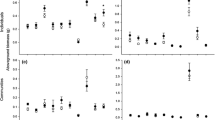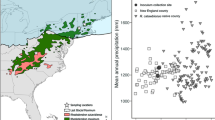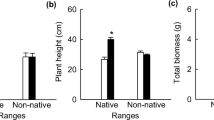Abstract
Lygodium microphyllum (Cav.) R. Br., a climbing fern native to the Pantropics of the Old World, is aggressively colonizing natural ecosystems in the Florida Peninsula. Here, we examined soil factors that might affect the fern’s invasiveness, specifically addressing the hypothesis that a release from natural belowground enemies contributes to its vigorous growth in Florida. We also investigated phenotypic differences of sporophytes raised from spores collected in Florida and the fern’s native range in Australia, hypothesizing that the Florida population would possess traits resulting in faster growth and superior competitive ability than the two Australian populations. We tested our hypotheses in parallel greenhouse experiments—one in Australia using soil from the fern’s native habitat, and another in Florida, USA, with soil from a recently colonized ecosystem. Fern growth rate and its principal determinants were expressed relative to the optimal growth with a common sand culture in each experiment and compared among treatments in which soil was altered through either sterilization or nutrient amendment, or both. Contrary to the expectation, the optimal growth rates in the sand culture were higher for Australian populations than the Florida population, while the comparatively poor growth of all populations in unaltered soil was stimulated by nutrient amendment and sterilization. The overall effect of sterilization, however, was muted under high-nutrient conditions, suggesting that the effect of soil sterilization may be due to greater nutrient availability in sterilized soils. The only exception was the local population from the site where the soil was collected for the experiment in Australia, which grew significantly faster in sterilized than in non-sterilized soil, and also more rapidly in response to soil insecticide application. Our results indicate that the invasiveness of L. microphyllum in Florida is not a simple phenotypic difference in inherent growth rate as predicted by the evolution of increased competitive ability hypothesis, but it may be mediated in part by release from soil-borne enemies that vary in their effectiveness even within the native geographical range of the fern.





Similar content being viewed by others
References
Aerts R, Chapin FS III (2000) The mineral nutrition of wild plants revisited: a re-evaluation of processes and patterns. Adv Ecol Res 30:1–67
Beckner J (1968) Lygodium microphyllum, another fern escaped in Florida. Am Fern J 58:93
Beckstead J, Parker IM (2003) Invasiveness of Ammophila arenaria: release from soil-borne pathogens? Ecology 84:2823–2831
Blair AC, Wolfe LM (2004) The evolution of an invasive plant: an experimental study with Silene latifolia. Ecology 85:3035–3042
Blossey B, Nötzold R (1995) Evolution of increased competitive ability in invasive nonindigenous plants—a hypothesis. J Ecol 83:887–889
Blumenthal DM (2006) Interactions between resource availability and enemy release in plant invasion. Ecol Lett 9:887–895
Buschmann H, Edwards PJ, Dietz H (2005) Variation in growth pattern and response to slug gamage among native and invasive provenances of four perennial Brassicaceae species. J Ecol 93:322–334
Callaway RM, Thelen GC, Rodriguez A, Holben W (2004) Soil biota and exotic plant invasion. Nature 427:731–733
DeWalt SJ, Denslow JS, Hamrick JL (2004) Biomass allocation, growth, and photosynthesis of genotypes from native and introduced ranges of the tropical shrub Clidemia hirta. Oecologia 138:521–531
Elton CS (1958) The ecology of invasions of animals and plants. Meuthen, London
Evans CG (1972) The quantitative analysis of plant growth. University of California Press, Berkeley
Franks SJ, Pratt PD, Dray FA, Simms EL (2008) No evolution of increased competitive ability or decreased allocation to defense in Melaleuca quinquenerevia since release from natural enemies. Biol Invasions 10:455–466
Gandiaga S, Volin JC, Kruger EL, Kitajima K (2009) Effects of hydrology on the growth and physiology of an invasive exotic, Lygodium microphyllum (Old World climbing fern). Weed Res 49:283–290
Goolsby JA (2004) Potential distribution of the invasive Old World climbing fern, Lygodium microphyllum in North and South America. Nat Area J 24:351–353
Goolsby JA, Wright AD, Pemberton RW (2003) Exploratory surveys in Australia and Asia for natural enemies of Old World Climbing fern, Lygodium microphyllum: Lygodiaceae. Biol Control 28:33–46
Goolsby JA, DeBarro PJ, Makinson JR, Pemberton RW, Hartley DM, Frohlich DR (2006) Matching the origin of an invasive weed for selecation of a herbivore haplotype for a biological control programme. Mol Ecol 15:287–297
Hierro JL, Villarreal D, Eren O, Graham JM, Callaway RM (2006) Disturbance facilitates invasion: the effects are stronger abroad than at home. Am Nat 168:144–156
Keane RM, Crawley MJ (2002) Exotic plant invasions and the enemy release hypothesis. Trends Ecol Evol 17:164–170
Kruger EL, Volin JC (2006) Reexamining the empirical relation between plant growth and leaf photosynthesis. Funct Plant Biol 33:421–429
Kruger EL, Volin JC, Lindroth RL (1998) Influences of atmospheric CO2 enrichment on the responses of sugar maple and trembling aspen to defoliation. New Phytol 140:85–94
Liu H, Stiling P (2006) Testing the enemy release hypothesis: a review and meta-analysis. Biol Invasions 8:1535–1545
Lott MS, Volin JC, Pemberton RW, Austin DF (2003) The reproductive biology of Lygodium microphyllum and L. japonicum (Schizaeaceae) and its implications for invasive potential. Am J Bot 90:1144–1152
Maron JL, Vilá M (2001) When do herbivores affect plant invasion? Evidence for the natural enemies and biotic resistance hypotheses. Oikos 95:361–373
Meyer G, Clare R, Weber E (2005) An experimental test of the evolution of increased competitive ability hypothesis in goldenrod, Solidago gigantea. Oecologia 144:299–307
Mitchell CE, Power AG (2003) Release of invasive plants from fungal and viral pathogens. Nature 421:625–627
Muller-Scharer H, Schaffner U, Steinger T (2004) Evolution in invasive plants: implications for biological control. Trends Ecol Evol 19:417–422
Pemberton RW (1998) The potential of biological control to manage Old World climbing fern (Lygodium microphyllum), an invasive weed in Florida. Am Fern J 88:176–182
Pemberton RW, Ferriter A (1998) Old World climbing fern (Lygodium microphyllum), a dangerous invasive weed in Florida. Am Fern J 88:165–175
Poorter H, Lambers H (1986) Growth and competitive ability of a highly plastic and a marginally plastic genotype of Plantago major in a fluctuating environment. Physiol Plant 67:217–222
Poorter H, van Devijver CADM, Boot RGA, Lambers H (1995) Growth and carbon economy of a fast-growing and a slow-growing grass species as dependent on nitrate supply. Plant Soil 171:217–227
Rayment GE, Higginson FR (1992) The Australian handbook of soil and water chemical methods. Inkata Press, Melbourne
Reinhart KO, Packer A, van der Putten WH, Clay K (2003) Plant-soil biota interactions and spatial distribution of black cherry in its native and invasive ranges. Ecol Lett 6:1046–1050
Rogers WE, Siemann E (2004) Invasive ecotypes tolerate herbivory more effectively than native ecotypes of the Chinese tallow tree Sapium sebiferum. J Appl Ecol 41:561–570
Schmidt IK, Michelsen A, Jonasson S (1997) Effects of labile soil carbon on nutrient partitioning between an arctic graminoid and microbes. Oecologia 112:557–565
Siemann E, Rogers WE (2001) Genetic differences in growth of an invasive tree species. Ecol Lett 4:514–518
Trevors JT (1996) Sterilization and inhibition of microbial activity in soil. J Microbiol Methods 26:53–59
Volin JC, Kruger EL, Lindroth RL (2002) Responses of deciduous broadleaf trees to defoliation in a CO2 enriched atmosphere. Tree Physiol 22:435–448
Volin JC, Lott MS, Muss JD, Owen D (2004) Predicting rapid invasion of the Florida Everglades by Old World Climbing Fern (Lygodium microphyllum). Divers Distrib 10:439–446
Willis AJ, Thomas MB, Lawton JH (1999) Is the increased vigour of invasive weeds explained by a trade-off between growth and herbivore resistance? Oecologia 120:632–640
Willis AJ, Memmott J, Forrester RI (2000) Is there evidence for the post-invasion evolution of increased size among invasive plant species? Ecol Lett 3:275–283
Wolfe LM (2002) Why alien invaders succeed: support for the escape-from-enemy hypothesis. Am Nat 160:705–711
Acknowledgments
The research was funded by competitive grants from the Florida Department of Environmental Protection and the South Florida Water Management District. A special note of acknowledgment goes to Dr. Susanne Schmidt, her post docs and students as well as her colleagues, Drs. Liz Aitken and Gimme Walter at the University of Queensland, who provided space and stimulating discussions during the Australian portion of the study. Special thanks go to Matthew Purcell, Tony Wright, and colleagues at the Commonwealth Scientific and Industrial Research Organization’s Australian Biological Control Laboratory: without their substantial assistance in the field, access to their growth facilities, and introduction to a proper Australian pie, the Australia study could not have been accomplished. Finally, we would like to thank many students, especially Andrew Ridley, on both sides of the World who helped with the harvests. The experiments comply with the current laws of both countries where they were performed.
Author information
Authors and Affiliations
Corresponding author
Rights and permissions
About this article
Cite this article
Volin, J.C., Kruger, E.L., Volin, V.C. et al. Does release from natural belowground enemies help explain the invasiveness of Lygodium microphyllum? A cross-continental comparison. Plant Ecol 208, 223–234 (2010). https://doi.org/10.1007/s11258-009-9700-6
Received:
Accepted:
Published:
Issue Date:
DOI: https://doi.org/10.1007/s11258-009-9700-6




